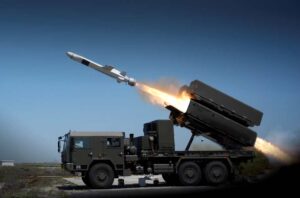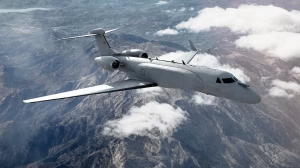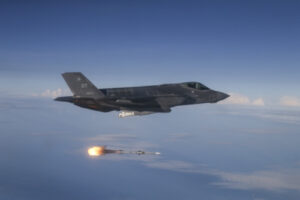Defense Daily
-
 International
InternationalU.S. OKs Potential $620 Million Naval Strike Missile Coastal Defense System Deal With Bulgaria
The State Department has approved a potential $620 million deal with Bulgaria for a Naval Strike Missile Coastal Defense System (NSM CDS). The Defense Security Cooperation Agency (DSCA) notified Congress […]
-
 Unmanned Systems
Unmanned SystemsDIU, Partners Select Finalists For Low-Cost Sensing Counter-Drone Challenge
The Defense Innovation Unit (DIU), U.S. Northern Command, and the Army on Monday announced 10 companies that will demonstrate their low-cost sensing technologies for counter-drone applications at a military exercise […]
-
 Army
ArmyHASC NDAA Requires JROC Certification Before Army Can Divest Extended Range Gray Eagles
The House Armed Services Committee’s version of the next defense policy bill requires the Army to receive certification from the Joint Requirements Oversight Council (JROC) before potentially divesting of its […]
-
 Advanced / Transformational Technology
Advanced / Transformational TechnologyBooz Allen Triples Venture Funding Commitment To $300 Million
Having expended most of the $100 million it set aside three years ago in venture capital funding, Booz Allen Hamilton [BAH] has tripled its venture commitment to $300 million for […]
-
 Air Force
Air ForceL3Harris and BAE Systems to Work Under $300 Million Italian Air Force Electronic Attack Contract
As the U.S. Air Force fields its EA-37B Compass Call electronic attack aircraft by L3Harris Technologies [LHX] and BAE Systems, the companies are now set to work on a new […]
Tagged in: -
 Business/Financial
Business/FinancialRune Technologies, Software Developer For Comprehensive Logistics, Raises $24 Million
Rune Technologies, a startup developing artificial intelligence-enabled software for managing, tracking, and predicting military logistics across all echelons, has closed a $24 million funding round it will invest to scale […]
Tagged in: -
 Uncategorized
UncategorizedHouse Appropriations Bill That Funds NNSA Clears Committee, Moves to Full House
The House appropriations committee voted to advance a fiscal 2026 appropriations bill Thursday that would give $25.317 billion to the National Nuclear Security Administration (NNSA). That’s around $1.182 billion above […]
-
Monday, July 21, 2025
- Defense Watch: Guetlein Confirmed, Comet Testing, New F-35 PEO
- Electronic Warfare Testing Demonstrating Warfighters Need Options For Drone Communications
- Anduril-Led Team Nabs $99.6 Million Army Deal To Deliver NGC2 Prototype Architecture
- L3Harris Unveils New Red And Green Wolf Aerial Munitions
- L3Harris R-GPS Prototype Review Aided by NTS-3 Payload
- York Space Systems To Acquire Global Ground SatCom Company ATLAS Space
- House Passes $831.5 Billion FY ‘26 Defense Spending Bill
- DoD, Partners Demonstrate Beyond Line-Of-Sight Drone Cargo Flights In National Airspace
-
Monday, July 21, 2025
- Defense Watch: Guetlein Confirmed, Comet Testing, New F-35 PEO
- Electronic Warfare Testing Demonstrating Warfighters Need Options For Drone Communications
- Anduril-Led Team Nabs $99.6 Million Army Deal To Deliver NGC2 Prototype Architecture
- L3Harris R-GPS Prototype Review Aided by NTS-3 Payload
- York Space Systems To Acquire Global Ground SatCom Company ATLAS Space
- L3Harris Unveils New Red And Green Wolf Aerial Munitions
- DoD, Partners Demonstrate Beyond Line-Of-Sight Drone Cargo Flights In National Airspace
- House Passes $831.5 Billion FY ‘26 Defense Spending Bill
-
 Army
ArmyAnduril-Led Team Nabs $99.6 Million Army Deal To Deliver NGC2 Prototype Architecture
The Army has awarded an Anduril-led team a $99.6 million deal to deliver a prototype architecture for its Next Generation Command and Control (NGC2) initiative, as it looks to scale […]

